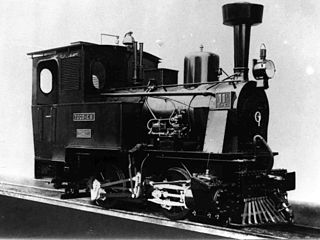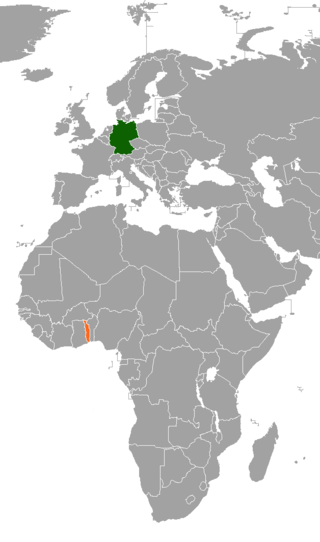The history of Togo can be traced to archaeological finds which indicate that ancient local tribes were able to produce pottery and process tin. During the period from the 11th century to the 16th century, the Ewé, the Mina, the Gun, and various other tribes entered the region. Most of them settled in coastal areas. The Portuguese arrived in the late 15th century, followed by other European powers. Until the 19th century, the coastal region was a major slave trade centre, earning Togo and the surrounding region the name "The Slave Coast".

The German colonial empire constituted the overseas colonies, dependencies, and territories of the German Empire. Unified in 1871, the chancellor of this time period was Otto von Bismarck. Short-lived attempts at colonization by individual German states had occurred in preceding centuries, but Bismarck resisted pressure to construct a colonial empire until the Scramble for Africa in 1884. Claiming much of the remaining uncolonized areas of Africa, Germany built the third-largest colonial empire at the time, after the British and French. The German colonial empire encompassed parts of several African countries, including parts of present-day Burundi, Rwanda, Tanzania, Namibia, Cameroon, Gabon, Congo, Central African Republic, Chad, Nigeria, Togo, Ghana, as well as northeastern New Guinea, Samoa and numerous Micronesian islands.

Togoland, officially the Togoland Protectorate, was a protectorate of the German Empire in West Africa from 1884 to 1914, encompassing what is now the nation of Togo and most of what is now the Volta Region of Ghana, approximately 90,400 km2 in size. During the period known as the "Scramble for Africa", the colony was established in 1884 and was gradually extended inland.

The Dagbamba or Dagomba are an ethnic group of Ghana, and Togo. They number more than 3.1 million people. The term Dagbamba is originally extended to refer to other related peoples who were unified by Naa Gbewaa including the Mamprusi and Nanumba. The Dagomba country is called Dagbon and they speak Dagbanli language. Dagbanli is the most spoken language of northern Ghana and second most widely spoken local language of Ghana. Dagbanli belongs to the Mabia (Mole-Dagbani) subgroup of the Gur languages, a large group of related languages in West Africa. The Dagomba practises both patrilineal and matrilineal systems of inheritance.

Atakpamé is the fifth largest city in Togo by population, located in the Plateaux Region of Togo. It is an industrial centre and lies on the main north-south highway, 161 km north of the capital Lomé. It is also a regional commercial centre for produce and cloth.

French Togoland was a French colonial League of Nations mandate from 1916 to 1946, and a UN trust territory from 1946 to 1960 in French West Africa. In 1960 it became the independent Togolese Republic.

The German West African Company, in German Deutsch-Westafrikanische Gesellschaft / Compagnie, was a German chartered company, founded in 1885. It exploited the two German protectorates in German West Africa but did not actually govern them — unlike its counterpart in German East Africa.

The strains in Ghana–Togo relations stretch back to pre-independence days.

Germany colonized Africa during two distinct periods. In the 1680s, the Margraviate of Brandenburg, then leading the broader realm of Brandenburg-Prussia, pursued limited imperial efforts in West Africa. The Brandenburg African Company was chartered in 1682 and established two small settlements on the Gold Coast of what is today Ghana. Five years later, a treaty with the king of Arguin in Mauritania established a protectorate over that island, and Brandenburg occupied an abandoned fort originally constructed there by Portugal. Brandenburg — after 1701, the Kingdom of Prussia — pursued these colonial efforts until 1721, when Arguin was captured by the French and the Gold Coast settlements were sold to the Dutch Republic.

The Salaga Area was the name of a disputed territory between the colonial powers Germany and Britain in the late 19th century, around the town of Salaga in today's northeast Ghana. Between 1889 and 1899, both powers considered the territory between their colonies of Togoland (Germany) and Gold Coast (UK), which was largely identical with the Kingdom of Dagomba, as neutral.

Gaston Thierry was a German officer and civil servant in Togo and Cameroon.
The Guan or Guang people are an ethnic group found almost in all parts of Ghana, including the Akyode people who speak Gikyode, Anii, [Krache language| Krachi]] people Nkonya tribe, the Gonja, Anum, Larteh, Akposo, Etsii in the Central Region, Nawuri, Nyagbo and Ntsumburu. The Guan are believed to have been the first settlers in modern day southern Ghana, migrating from the Mossi-Dagbon region of modern Ghana and Burkina around 1000 A.D. The Gonja of the Guan are however late settlers in northern Ghana, invading eastern Dagbon in the 1600s, capturing Daboya and many towns.

The Togoland campaign was a French and British invasion of the German colony of Togoland in West Africa, which began the West African campaign of the First World War. German colonial forces withdrew from the capital Lomé and the coastal province to fight delaying actions on the route north to Kamina, where the Kamina Funkstation linked the government in Berlin to Togoland, the Atlantic and South America.

The Affair of Agbeluvoe ["affair" a military engagement by a force less than a division] (Agbéluvhoé, Beleaguer or the Battle of Tsewie, was fought during the First World War between invading British Empire soldiers of the West African Rifles and German Polizeitruppen in German Togoland on 15 August 1914. British troops occupying the Togolese capital of Lomé on the coast, had advanced towards a wireless station at Kamina, 100 mi inland on hills near Atakpamé. The only routes inland were by the railway and road, which had been built through dense and almost impassable jungle.

The Affair of Khra [Chra] was fought by British and French troops against German Polizeitruppen in the village of Khra, near the Khra River on 22 August 1914, during the Togoland Campaign of the First World War. The German defenders mined the approaches to the river, blew the bridges and dug in around the village on the far bank, ready to defend the crossing with rifles and three concealed machine-guns. The British–French attack was repulsed and then a German counter-attack was ordered but many troops refused the order and the attack was not delivered.

Rail transport in Togo began in 1905.

The Kingdom of Dagbon is the oldest and one of the most organised traditional kingdoms in Ghana founded by the Dagomba people (Dagbamba) in the 15th century. During its rise, it comprised, at various points, the Northern, Upper West, Upper East, Savannah Region and North East regions of present-day Ghana. It also covered portions of Burkina Faso, North East Ivory Coast and North West Togo. Since Ghana's independence in 1957, the Kingdom has assumed a traditional, customary role like Ghana's other kingdoms and ethnic states.
The Zabarma Emirate was an Islamic state that existed from the 1860s to 1897 in what is today parts of Ghana and Burkina Faso.

The Ghana–Togo border is 1,098 km in length and runs from the tripoint with Burkina Faso in the north to the Atlantic Ocean in the south.

Germany–Togo relations are shaped by the shared past of both countries. From 1884 to 1914, Togo was a colony of Germany under the name of Togoland.













